MEA Frozen Food Market Size
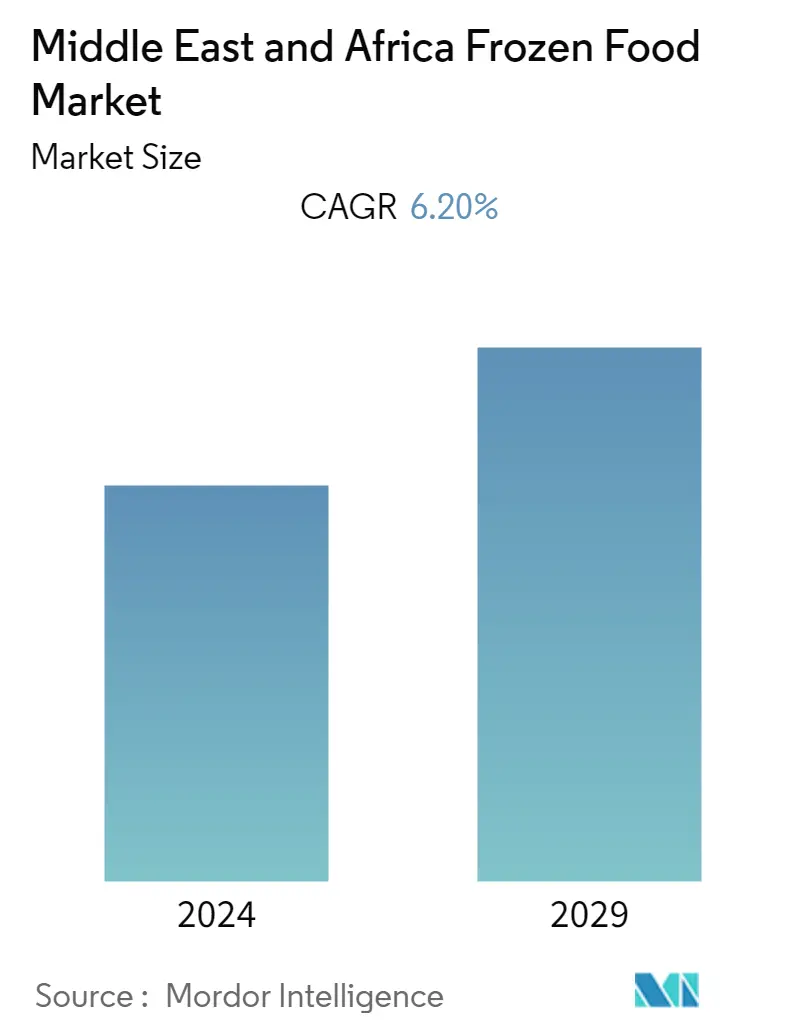
| Study Period | 2019 - 2029 |
| Base Year For Estimation | 2023 |
| Forecast Data Period | 2024 - 2029 |
| Historical Data Period | 2019 - 2022 |
| CAGR | 6.20 % |
| Market Concentration | Low |
Major Players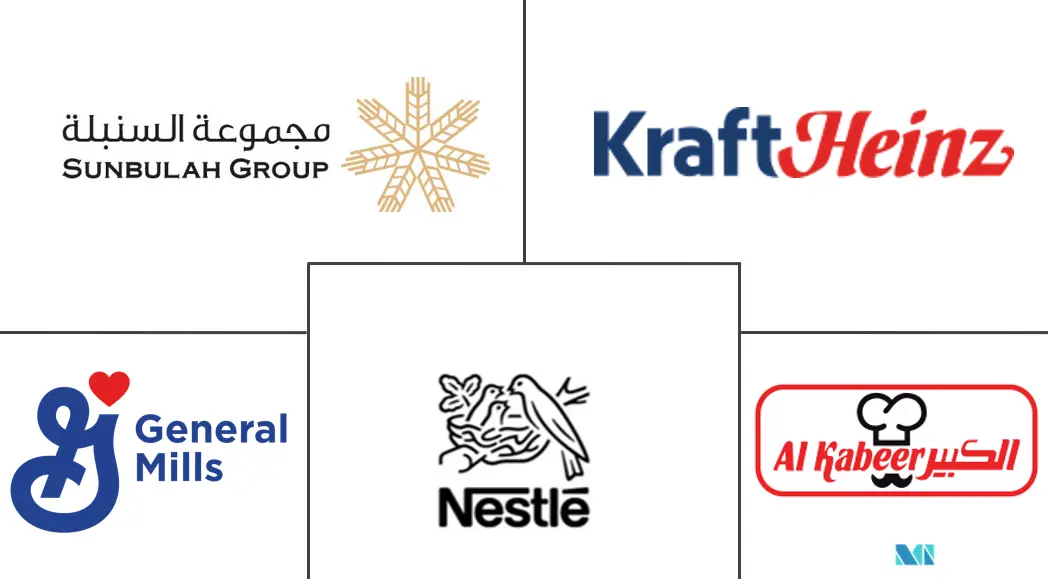
*Disclaimer: Major Players sorted in no particular order |
MEA Frozen Food Market Analysis
The Middle East & Africa Frozen Food market is projected to register a CAGR of 6.2% during the forecast period, 2022-2027.
Rapid urbanization, lack of time to cook, increasing demand for convenient food, improved living standards, and the presence of a high percentage of expatriates are driving the demand for frozen food in the region. Millennials and the Gen Z population are more inclined toward frozen foods owing to their willingness of trying new varieties of convenience food such as frozen snacks and frozen ready meals.
The attributes of frozen foods such as easier storage, preserved nutrition at peak ripeness, extended shelf life, and reduction in food waste are boosting the growth of frozen food sales in the region. Additionally, the increasing number of modern retail formats in the country and the availability of a greater variety of frozen ready-to-eat meals have attracted urban consumers who are seeking packaged food products due to their fast-paced lifestyle, thereby leading to a noticeable increase in demand.
During the COVID-19 pandemic, the demand for non-perishable food products such as frozen food witnessed a huge surge in consumer demand, mainly due to the stockpiling nature of the consumers, caused by extended lockdowns.
MEA Frozen Food Market Trends
This section covers the major market trends shaping the MEA Frozen Food Market according to our research experts:
Increasing Demand for Convenience Food
A surge in the number of employed population across the region has resulted in the growing demand for convenient food formats which is driving the demand for frozen food. According to International Labour Organization Qatar has the highest working population with 87% of labor force participation in 2021. The working population is inclined toward convenient food including precooked and frozen meals such as vegetable meals, meatballs, ready-to-eat, ready-to-cook, and other frozen food products due to hectic work schedules. Moreover, consumers are opting for frozen foods to prevent the frequent buying of perishable foods which should be used within a shorter period, unlike frozen food with a longer shelf life. Furthermore, with sweet indulgence, frozen desserts, such as ice creams, are highly appreciated among consumers in the country. Thus, global manufacturers are adopting various strategies to meet consumers' demands. For instance, Mars acquired its Dubai subsidiary, following the new UAE law on foreign ownership. It previously owned 49% of the shares in Dubai LLC. This acquisition strengthened its presence and development in the Middle East, including the United Arab Emirates.
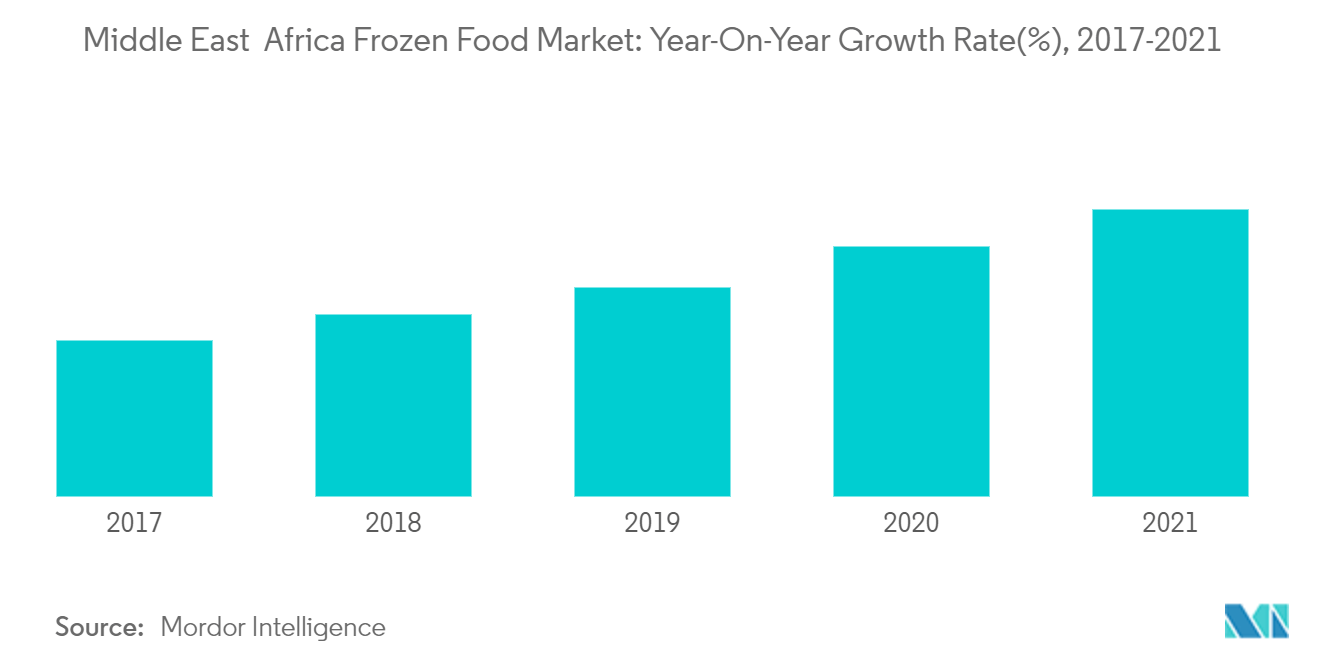
Saudi Arabia Holds Largest Share in the Market
With the increasing number of double-income families in Saudi Arabia, there is a growing demand for quick and easy-cook meal solutions. The primary driver of the frozen food market in the future will be the growing consumer inclination towards frozen desserts, ready-to-eat meals, and frozen meat products. For instance, according to the consumer behavior study conducted by Siwar Foods, a Saudi-based FMCG company, 80% of consumers in the country are open to purchasing frozen food, with taste, variety, quality, and affordability as the most important drivers of choice. Like other gulf nations, Saudi Arabia is heavily dependent on imports to meet local demand as a result of poor rates of self-sufficiency in terms of food production. Due to their high retail stability and ease of importation, frozen food products are more common in the nation than in other food formats. Moreover, aided by the high population of Saudi Arabia than other regional countries, the consumption volume of food is much higher. The main exporters of processed meat to Saudi Arabia are European countries, such as France and the Netherlands.
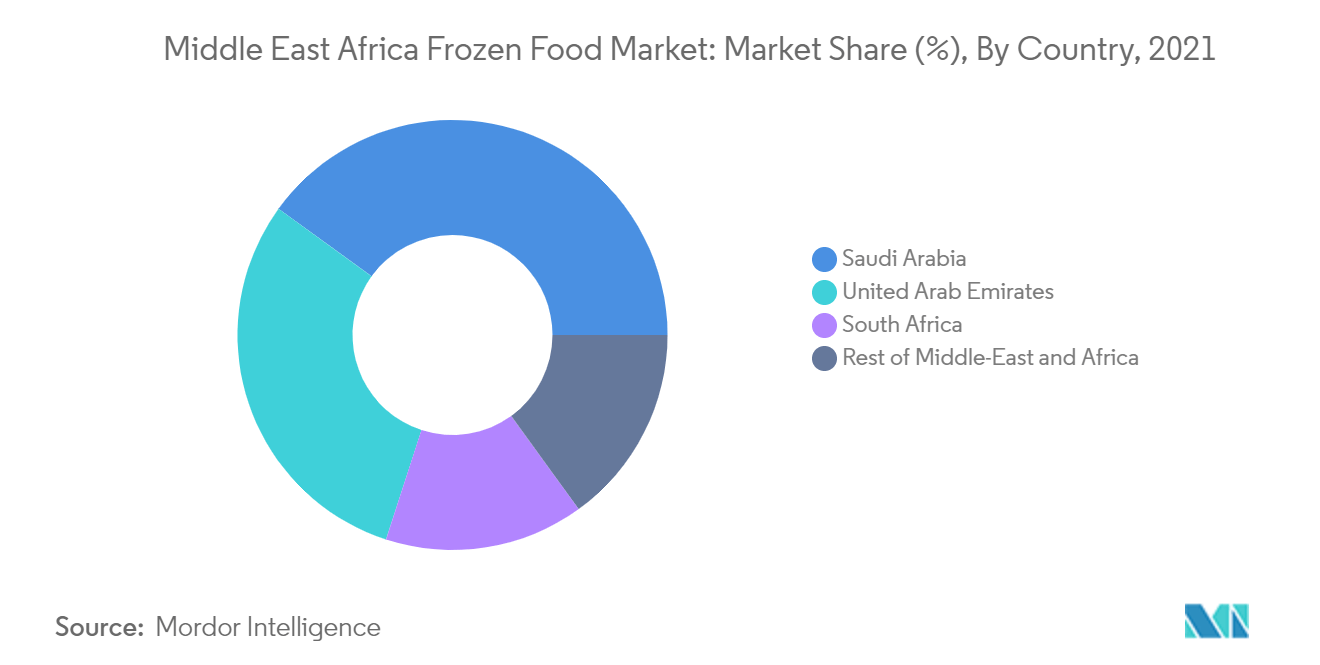
MEA Frozen Food Industry Overview
The Middle East & Africa Frozen Food Market is fragmented and highly competitive with many regional and international players in the region. The key players in the region include Sunbulah Group, General Mills Inc., and Al Kabeer Group among others. The major companies in the region are investing in research and development to innovate their product offerings such as halal-certified and organic frozen food. The majority of the foreign brands partner with regional companies for the distribution of their frozen food offerings across the Middle East and Africa. For instance, South Africa's RFG Holdings has acquired frozen-food assets from local peer Pioneer Foods for an undisclosed sum.
MEA Frozen Food Market Leaders
-
General Mills Inc.
-
Nestle S.A.
-
Al Kabeer Group
-
Sunbulah Group
-
Kraft Heinz Company
*Disclaimer: Major Players sorted in no particular order
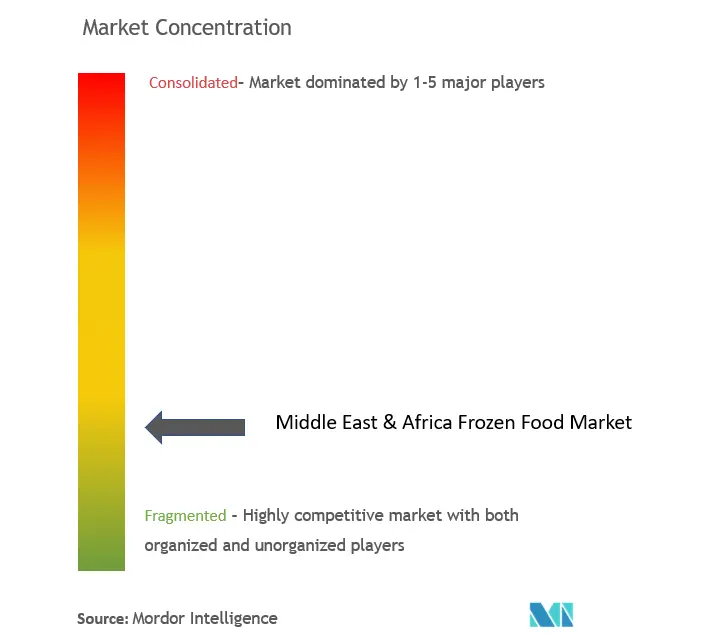
MEA Frozen Food Market News
- In August 2022, Seara, a Brazilian food brand launched its complete halal portfolio in Saudi Arabia. The portfolio comprises 120 frozen food products, including frozen whole chicken, chicken parts, breaded chicken, chicken and beef burgers, minced meats, sausages, meatballs, frozen vegetables, frozen seafood, and frozen fruits, among others.
- In March 2021, United Arab Emirates-based producer of frozen halal products Al Islami Foods unveiled a new dough category, starting with frozen paratha, as it looks to expand the availability, variety, and visibility of the brand.
- In January 2022, Simplifine, a food processing company, expanded its product portfolio by launching a production line of frozen fresh French fries in Kenya.
MEA Frozen Food Market Report - Table of Contents
1. INTRODUCTION
- 1.1 Study Assumptions and Market Definition
- 1.2 Scope of the Study
2. RESEARCH METHODOLOGY
3. EXECUTIVE SUMMARY
4. MARKET DYNAMICS
- 4.1 Market Drivers
- 4.2 Market Restraints
-
4.3 Porter's Five Force Analysis
- 4.3.1 Threat of New Entrants
- 4.3.2 Bargaining Power of Buyers/Consumers
- 4.3.3 Bargaining Power of Suppliers
- 4.3.4 Threat of Substitute Products
- 4.3.5 Intensity of Competitive Rivalry
5. MARKET SEGMENTATION
-
5.1 By Product Type
- 5.1.1 Frozen Fruit and Vegetable
- 5.1.2 Frozen Poultry and Seafood
- 5.1.3 Frozen Prepared Food
- 5.1.4 Frozen Dessert
- 5.1.5 Frozen Snack
- 5.1.6 Others
-
5.2 By Distribution Channel
- 5.2.1 Supermarket/Hypermarket
- 5.2.2 Grocery Stores
- 5.2.3 Convenience Store
- 5.2.4 Online Retailer
- 5.2.5 Others
-
5.3 By Geography
- 5.3.1 United Arab Emirates
- 5.3.2 Saudi Arabia
- 5.3.3 South Africa
- 5.3.4 Rest of Middle-East and Africa
6. COMPETITIVE LANDSCAPE
- 6.1 Most Adopted Strategies
- 6.2 Market Share Analysis
-
6.3 Company Profiles
- 6.3.1 Mccain Foods Limited
- 6.3.2 American Group, Inc.
- 6.3.3 Sunbulah Group
- 6.3.4 General Mills Inc.
- 6.3.5 Kerry Group
- 6.3.6 Nestle S.A.
- 6.3.7 Kraft Heinz Company
- 6.3.8 Tyson Foods, Inc.
- 6.3.9 Al Kabeer Group
- 6.3.10 Grupo Bimbo S.A.B. De C.V
- *List Not Exhaustive
7. MARKET OPPORTUNITIES AND FUTURE TRENDS
8. IMPACT OF COVID-19 ON THE MARKET
9. DISCLAIMER
** Subject To AvailablityMEA Frozen Food Industry Segmentation
Frozen food is defined as food products that are preserved under low temperatures and used over a long period. The frozen food market is segmented by product type, product category, distribution channel, and geography. By product type, the market is segmented into frozen fruits and vegetables, frozen snacks, frozen seafood, frozen meat and poultry, frozen desserts, and other product types. By product category, the market is classified as ready-to-eat, ready-to-cook, and others. By distribution channel, the market is segmented into supermarkets/hypermarkets, convenience stores, online retail channels, and other distribution channels. It provides an analysis of the frozen food market in the emerging and established markets across the region, including United Arab Emirates, Saudi Arabia, South Africa, and Rest of Middle East and Africa. The report offers market size and forecasts in value (USD million) for the above segments.
| By Product Type | Frozen Fruit and Vegetable |
| Frozen Poultry and Seafood | |
| Frozen Prepared Food | |
| Frozen Dessert | |
| Frozen Snack | |
| Others | |
| By Distribution Channel | Supermarket/Hypermarket |
| Grocery Stores | |
| Convenience Store | |
| Online Retailer | |
| Others | |
| By Geography | United Arab Emirates |
| Saudi Arabia | |
| South Africa | |
| Rest of Middle-East and Africa |
MEA Frozen Food Market Research FAQs
What is the current Middle East & Africa Frozen Food Market size?
The Middle East & Africa Frozen Food Market is projected to register a CAGR of 6.20% during the forecast period (2024-2029)
Who are the key players in Middle East & Africa Frozen Food Market?
General Mills Inc., Nestle S.A., Al Kabeer Group, Sunbulah Group and Kraft Heinz Company are the major companies operating in the Middle East & Africa Frozen Food Market.
What years does this Middle East & Africa Frozen Food Market cover?
The report covers the Middle East & Africa Frozen Food Market historical market size for years: 2019, 2020, 2021, 2022 and 2023. The report also forecasts the Middle East & Africa Frozen Food Market size for years: 2024, 2025, 2026, 2027, 2028 and 2029.
Middle East & Africa Frozen Food Industry Report
Statistics for the 2024 Middle East & Africa Frozen Food market share, size and revenue growth rate, created by Mordor Intelligence™ Industry Reports. Middle East & Africa Frozen Food analysis includes a market forecast outlook to 2029 and historical overview. Get a sample of this industry analysis as a free report PDF download.



